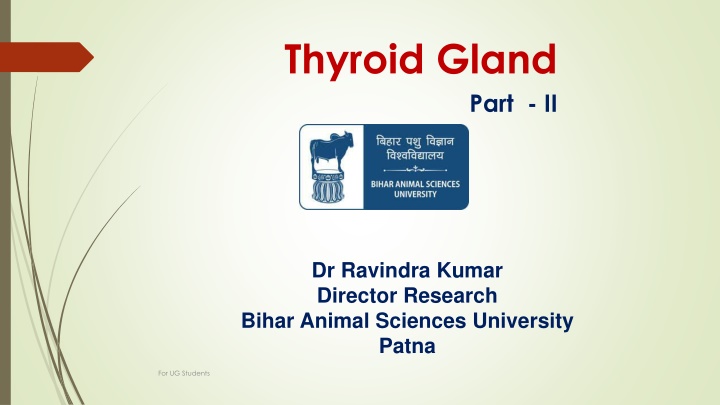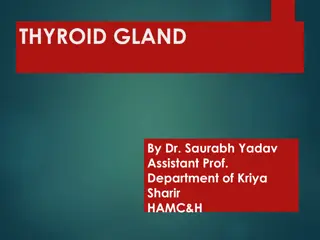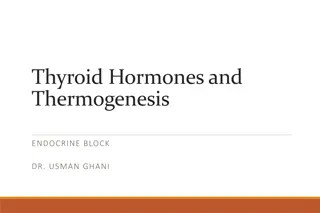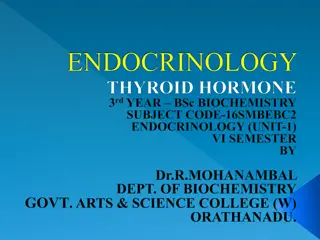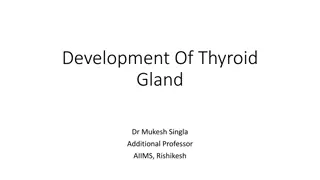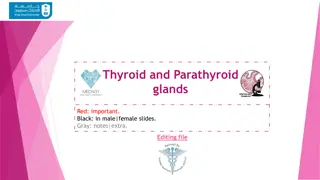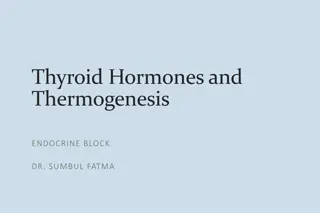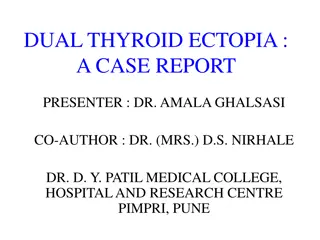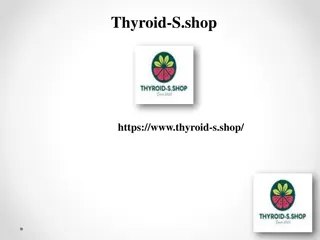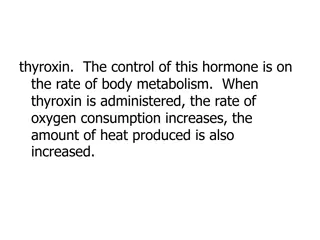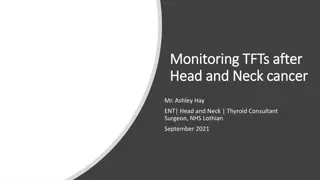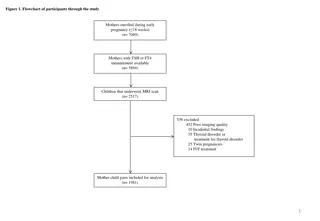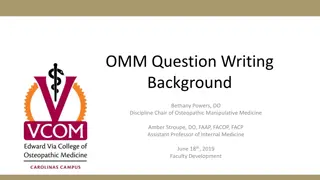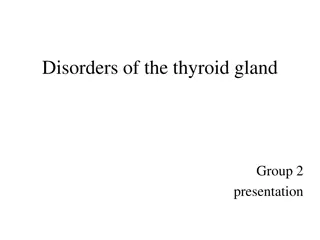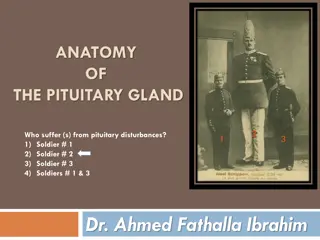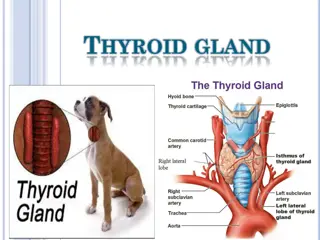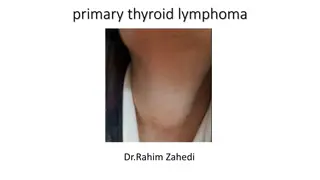Thyroid Gland Functions and Dysfunctions
Thyroid glands play a vital role in regulating metabolism and various physiological functions. Explore the mode of action of thyroxine, control of thyroid functions, diverse roles of thyroid hormones, and common dysfunctions like hypothyroidism. Learn about primary and secondary hypothyroidism in domestic animals and their treatments.
Download Presentation

Please find below an Image/Link to download the presentation.
The content on the website is provided AS IS for your information and personal use only. It may not be sold, licensed, or shared on other websites without obtaining consent from the author.If you encounter any issues during the download, it is possible that the publisher has removed the file from their server.
You are allowed to download the files provided on this website for personal or commercial use, subject to the condition that they are used lawfully. All files are the property of their respective owners.
The content on the website is provided AS IS for your information and personal use only. It may not be sold, licensed, or shared on other websites without obtaining consent from the author.
E N D
Presentation Transcript
Thyroid Gland Part - II Dr Ravindra Kumar Director Research Bihar Animal Sciences University Patna For UG Students
Mode of action of thyroxine Not well understood. important effect of T4 is stimulation of oxygen utilization, hence its also related with increased BMR. causes increase in mitochondria per unit body tissue, thus more metabolic activity per cell in the body. In addition thyroxine is known to cause an increased permeability of mitochondrial membranes (by causing swelling) which facilitates certain phosphorylation reactions. Receptors for thyroid hormones are on chromatin material of cell nucleus, where as for steroid hormones its cytoplasm.
Functions of thyroid hormones Molting Hibernation Growth Reproduction and lactation
Thyroid Dysfunctions Hypothyroidism : It means lower functioning of thyroid leading to decrease in circulating thyroid hormones T4 and/or T3. This could lead to at least 3 deficiencies/diseases: - Iodine deficiency - Primary Hypothyroidism - Secondary Hypothyroidism
Primary Hypothyroidism Decreased Secretion of thyroid hormones due to malfunctioning of the gland. Several factors like thyroiditis, neoplasms that destroy the follicle cells or alterations in biochemical mechanism involved in formation of T4. Clinical signs of primary hypothyroidism in dogs are inactiveness, sleepy, lack of vigour, seek warm places and may gain weight if appetite is good and thickening of skin particularly in face region is there. Reproductive dysfunctions are also observed.
Treatment of hypothyroidism -Desicated thyroid -Thyroglobulin - T4 (Synthroid) - T3 Sodium leothyronine (Cytobin) @ 0.2 to 0.3 mg for 10-15 Kg for dog. Effects are seen with in a week or so.
Secondary Hypothyroidism It is relatively rare in domestic animals. It is caused by hypothalamic or pituitary defect leading to release of insufficient TSH-RH or TSH, resulting in low production or lack of stimulation of thyroid follicles. Usually it is due to tumors of adenohypophysis. Symptoms are dwarfism, which can be diagnosed with TSH response test and treated with thyroid preparations.
Hyperthyroidism It is less common in domestic animals, in comparison to hypothyroidism. Its due to overproduction of TSH due to pituitary tumors excess production of thyroxine due to thyroid gland tumors. In dogs mostly primary hypothyroidism is due to malignant tumors and treatment is not so successful. Clinical signs are : weight loss, Polyphagia, muscle weakness, fatigue, nervousness, heat tolerance and polyurea.
Compounds/Goitrogens Defined as those, which interferes with basal metabolic rate by altering the synthesis release or peripheral action of thyroid hormone. Cabbage contain goitrogens. Other anti thyroid drugs are : thiourea, thiouracil and their derivatives.
Classification of antithyroid drugs according to their mode of action is Drugs inhibit iodide trapping : Thiocynates (Raw soybeans & cabbage) Perclorates. Inhibition of T4 synthesis Thiouracil Propylthiouracil Methy thiouracil Thiourea Methimazole
Destruction of thyroid tissue 131I in large doses Mode of action unknown Iodine is much higher doses than required
Thyroid function tests BMR : O2 consumption not practical in animals. 131I uptake : method and external monitoring. PBI reflects T3 & T4 levels in circulation. But is subject to take reports due to dietary iodine etc. T3,T4 : RIA, ELISA etc. TSH Response test : It consist of administration of 10 units of TSH (Dermathycin) and measuring T4 at 0 & 10 hrs after TSH injection. In normal dog T4 level doubles to resting stage. If T4 at 10 hrs is less than double then dog is suffering from secondary hypothyroidism. Cholesterol level is elevated above 300 mg/dl in many hypothyroid dogs, but still diet can also cause elevation. Thyroid biopsy
